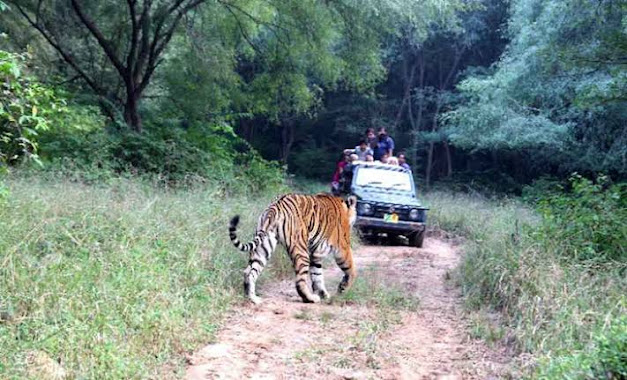Exploring Ranthambore: A Wild Escape to Nature and History
Ranthambore, a name synonymous with the thrill of wildlife and the splendor of Rajasthan's historic landscape, is one of India’s most popular national parks. Nestled in the Sawai Madhopur district, Ranthambore is famous for its royal Bengal tigers and a fascinating blend of nature and history. Here's a detailed look at what makes Ranthambore a must-visit destination for travelers seeking adventure and a glimpse into India’s wildlife heritage.
1. The Story Behind Ranthambore
Ranthambore National Park was once the hunting grounds of the Maharajas of Jaipur. In 1955, it became a wildlife sanctuary, and in 1973, it was included in Project Tiger to protect India’s dwindling tiger population. Today, it spans an area of around 1,334 square kilometers and boasts a diverse range of flora and fauna.
2. Wildlife Adventure in Ranthambore
The park is one of the
finest places to see tigers in their natural habitat. The majestic big cats
roam freely here, and the thrill of spotting one of these elusive creatures
draws visitors from around the world. The best time to visit Ranthambore is
between October and April, when the chances of seeing tigers are the highest.
Aside from tigers,
Ranthambore is home to other animals such as leopards, sloth bears, hyenas,
wild boars, and a variety of deer including sambars and chitals. Birdwatchers
will also be thrilled by over 300 species of birds like painted storks, Indian
eagle owls, and crested serpent eagles that inhabit the park.
One of the unique aspects of Ranthambore is the Ranthambore Fort, a UNESCO World Heritage site, which lies within the national park. This imposing structure stands atop a hill, offering spectacular views of the surrounding landscape. Dating back to the 10th century, the fort reflects the rich history of Rajasthan and was a strategic defense structure for the ruling dynasties of the region. Exploring the fort reveals ancient temples, cenotaphs, and pavilions, each carrying tales of a glorious past.
One of the best ways to
explore the wilderness of Ranthambore is through Jeep and Canter safaris. The
safaris are conducted twice a day — in the early morning and late afternoon. A
Jeep safari, accommodating up to 6 people, offers an intimate experience, allowing
you to venture deeper into the forest. A Canter safari, which can accommodate
up to 20 people, is also an exciting way to see the park and is ideal for group
travelers. Both options give you a chance to observe wildlife up close in their
natural habitat.
5. Zones of Ranthambore
Ranthambore National Park is
divided into 10 safari zones, each offering a different experience. Zones 1 to
5 are the most popular and known for frequent tiger sightings, while zones 6 to
10 are less crowded but provide equally amazing wildlife experiences. Exploring
different zones gives you a better chance to spot a variety of animals and
birds.
6. Padam Talao and Other
Lakes
The park is dotted with
several lakes, the most famous being Padam Talao, the largest lake in Ranthambore.
It is often visited by tigers and other animals for water, making it a hotspot
for sightings. The lakes of Rajbagh and Malik Talao are also must-visit spots,
where you can often see crocodiles basking in the sun.
7. Flora of Ranthambore
The vegetation in
Ranthambore primarily consists of dry deciduous forests, dominated by Dhok
trees, interspersed with open grasslands. During the summer, the forest
transforms into golden hues, while during the monsoon, the park turns lush
green, creating a beautiful contrast against the park’s rugged terrain.
8. How to Reach Ranthambore
Ranthambore is
well-connected by road, rail, and air. The nearest town is Sawai Madhopur,
which has a railway station that connects to major cities like Delhi, Jaipur,
and Mumbai. The nearest airport is in Jaipur, around 180 kilometers away,
making it convenient for international and domestic travelers to reach the
park.
9. Where to Stay in
Ranthambore
Ranthambore offers a variety
of accommodation options ranging from luxury resorts to budget lodges. Many of
these are designed to blend with the natural surroundings and offer an
immersive experience. Some luxury properties even offer glamping (luxury
camping), giving guests the chance to stay close to nature without compromising
on comfort.
10. Best Time to Visit
The best time to visit
Ranthambore National Park is during the winter and early summer months (October
to April). During these months, animals are more likely to come out to water
bodies, increasing your chances of spotting a tiger. However, the park remains
closed from July to September during the monsoon season.
11. Responsible Tourism
When visiting Ranthambore,
it’s important to be a responsible tourist. Respect the park’s rules, maintain
silence during safaris, and avoid littering. Conserving the park’s beauty
ensures that it remains a haven for wildlife for future generations to enjoy.
12. Other Attractions Nearby
Ranthambore has more to
offer beyond the national park. The Rajiv Gandhi Regional Museum of Natural
History in Sawai Madhopur provides insights into the region’s wildlife, while
the Khandar Fort, about 40 kilometers away, is another historical attraction
worth visiting for those interested in Rajasthan’s heritage.
Conclusion
Ranthambore is a perfect
blend of thrilling wildlife experiences and rich historical heritage. Whether
it’s watching a tiger prowling through the dry grasslands, exploring the
majestic Ranthambore Fort, or simply soaking in the natural beauty of its
lakes, Ranthambore offers an unforgettable escape into the wild heart of
Rajasthan. Whether you’re a nature enthusiast, a photographer, or someone
looking to experience the thrill of the jungle, Ranthambore is sure to leave
you with memories of a lifetime.
Make sure to plan your trip
ahead, book safaris in advance, and prepare for an adventure that’s both
exhilarating and enriching. Ranthambore is more than just a wildlife park; it’s
a journey into India’s natural and historical legacy.







Comments
Post a Comment